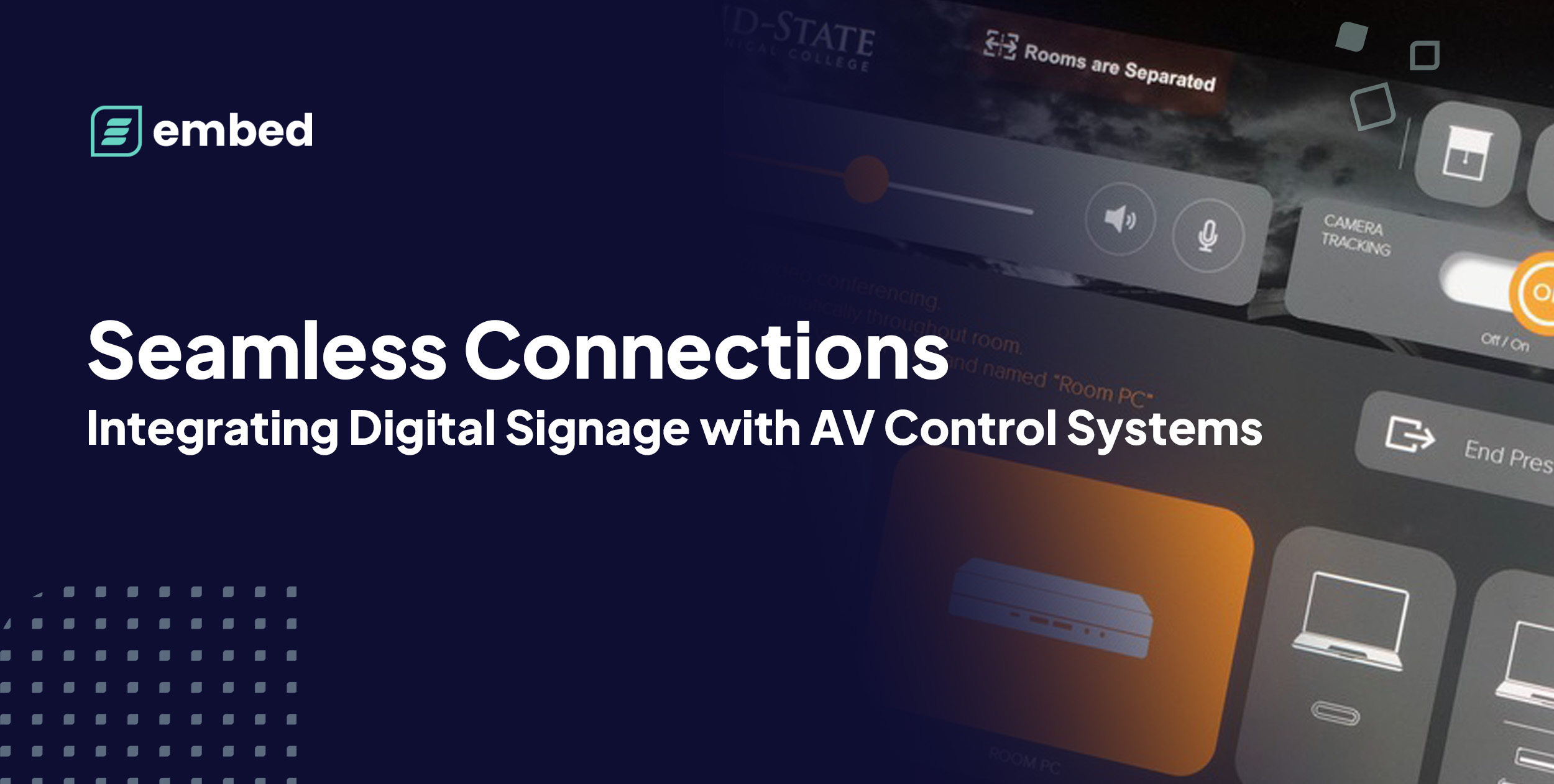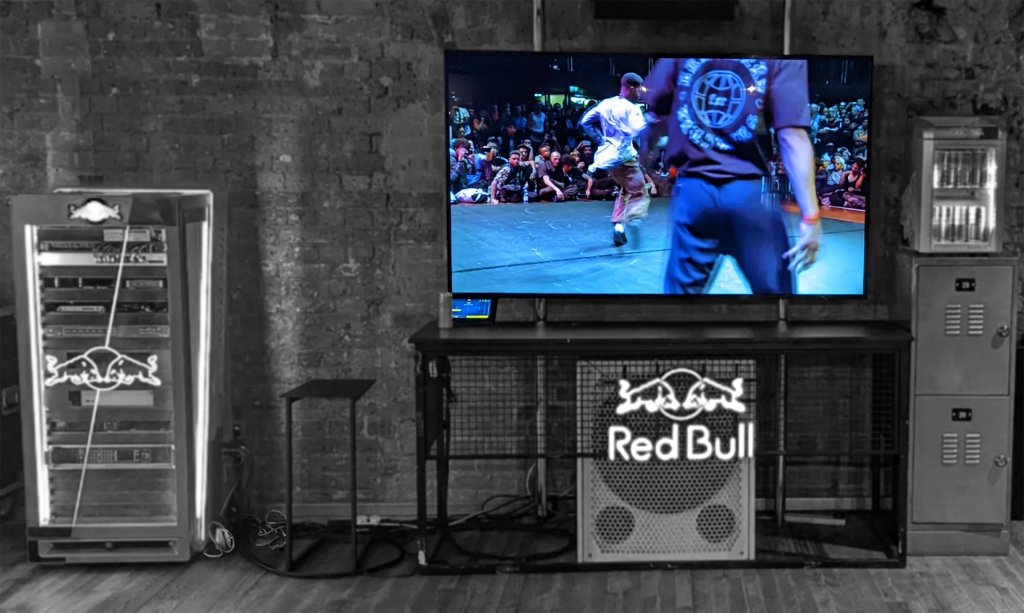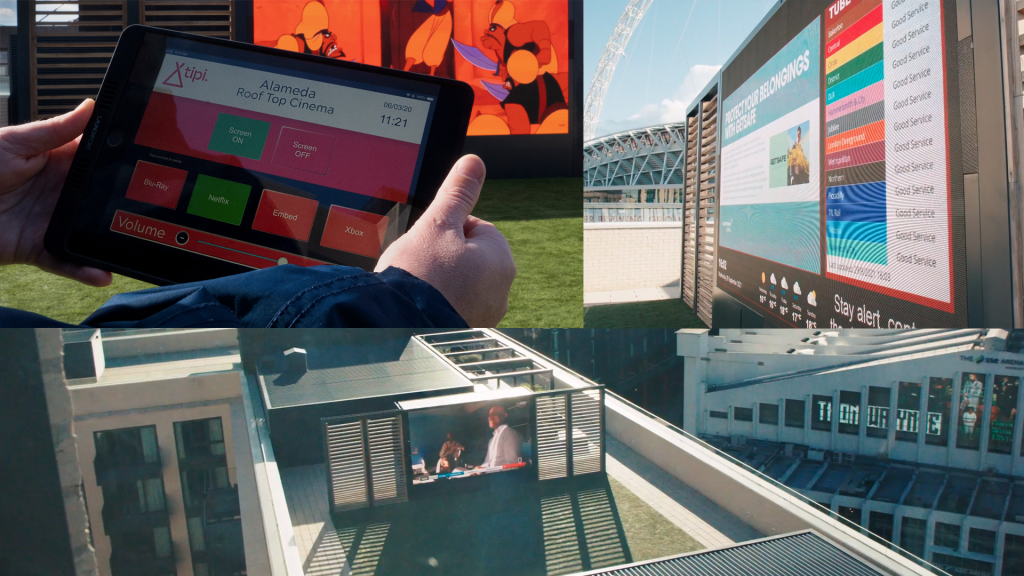Seamless Connections: Integrating Digital Signage with AV Control Systems

Digital Signage forms part of the AV world but is often considered separately. This article dives into the synergy between AV control systems and digital signage, shedding light on how technologies can combine to streamline the way businesses communicate with their audiences.
Keep reading if you want to understand the foundational principles of digital signage software and AV control systems. We’ll be exploring the various connection protocols; RS232, TCP, UDP and GPIO that facilitate the smooth integration and management of digital signage, and highlighting industry-leading platforms like Q-SYS, Kramer, SY Electronics, Crestron and Extron. We’ll also be sharing real-world examples of the application of these technologies with industry expert perspectives to showcase the potential of combining digital signage with AV Control systems in creating engaging and effective visual communication solutions.
Want to jump ahead? Here’s the table of contents:
- The Basics: What is Digital Signage?
- The Basics: What is an AV Control System?
- Connecting the Dots: Protocols and Inputs
- Types of AV Systems and Controllers
- Piecing it All Together at Mid-State Technical College
- Benefits of using Digital Signage and AV Control Systems
- Are you using Digital Signage with AV Control systems?
The Basics: What is Digital Signage?
Imagine walking into a space where the walls come to life, engaging you with vibrant, dynamic content. That’s the magic of digital signage – it’s a versatile technology that transforms how businesses communicate, entertain, and educate their audiences. It’s not just about showing ads or information; it’s about creating memorable experiences that connect on a personal level.
In basic terms, Digital signage is a tool that enables businesses to effectively communicate with their audience via display technology. This includes small tablet devices, large format commercial displays, video walls and large scale LED walls to name a few.
Digital signage software ( for example) is the backbone of an effective digital signage display network, enabling businesses to effortlessly manage and display content on digital screens.
The Basics: What is an AV Control System?
An AV Control System serves as the nerve center of audiovisual technology, seamlessly integrating various components to deliver a cohesive and immersive experience.
At its core, an AV System is responsible for enabling users to easily control audio visual devices such as projectors, displays, speakers and lighting systems. The AV Control System simplifies the complex, making it easier for businesses to deliver experiences that resonate.
With digital signage being a prominent communication tool, it’s becoming entwined into the overall AV system mix. Whether it’s the soft background music that complements the visuals or the seamless transition between different types of content, AV control systems ensure everything works in harmony to engage the senses fully.
Connecting the Dots: Protocols and Inputs
In the digital world there are various protocols of communication. Below are some of the most common examples used in the pro AV world:
RS232 (Recommended Standard 232): The Steady Connector
RS232 is a serial communication protocol commonly used for connecting and controlling devices in AV systems. It employs a simple, one-way communication method where data is sent sequentially bit by bit. RS232 is often used to transmit commands and receive status information between devices, enabling seamless integration and control of various AV components.
TCP (Transmission Control Protocol): The Reliable Communicator
TCP is a reliable and connection-oriented communication protocol widely used in networking. In the context of digital signage and AV systems, TCP ensures the secure and ordered transmission of data between devices over a network. It allows for the establishment of a stable connection, making it suitable for scenarios where accurate and error-free data transfer is crucial for controlling and coordinating AV equipment.
UDP (User Datagram Protocol): The Speedster
UDP is designed to be a fast, connectionless communication protocol that prioritises speed over reliability. In the context of digital signage, UDP can be employed for real-time and rapid data transmission between devices in an AV system. While it may not guarantee the delivery of every packet, its speed makes it suitable for applications where a slight loss of data is acceptable.
GPIO (General Purpose Input/Output): The Direct Link
GPIO is not a communication protocol but rather a set of pins on a device that can be configured as inputs or outputs. In the context of digital signage and AV systems, GPIO is often used for hardware-level control. It enables direct interaction between devices by sending or receiving electrical signals. For example, a digital signage player might use GPIO to trigger events like turning on/off a display, activating a sensor, or signalling other devices within the AV ecosystem.
Types of AV Systems and Controllers
There are many, many manufacturers and systems that can be used to control AV systems and we’ve outlined below a few leading systems that are worth exploring:
Q-SYS
In preparation for this article, we had the pleasure of speaking with Rob Sherry, Sales Director at Q-SYS who provided an excellent overview of the Q-SYS. It’s clear that Q-SYS stands as a testament to ultimate flexibility and power when it comes to AV control.
Q-SYS is a platform developed by QSC for audio, video and control and is ‘network first’ software with the flexibility to manage all types of AV experiences with a wide range of underpinning connectors/hardware.
Q-SYS Control is a powerful control engine for managing and automating various aspects of AV systems. It allows users to create custom user interfaces and to automate control functions and this is where digital signage ties in. By using Q-SYS Control, it’s possible to create user interfaces for control devices to manage changes on digital signage. Then with the digital signage being able to send back commands to Q-SYS control, it makes for a seamless two way interactive experience.
Bringing these components together in real world environments are industry heroes… AV System Integrators, Solutions Architects, Technical Consultants… Sam Shelton, Director at Carrier Labs, shared his insight into their experience of using AV Control systems with Digital Signage.
“We use for managing digital signage content across multiple screens at the Red Bull UK HQ. We’ve implemented a Q-SYS control system where the on-site AV team can change screen content between live streams and a variety of content at a touch of a button. Setting this up was incredibly easy, we can configure custom ASCII commands in Q-SYS and fire these over TCP or UDP to the players to change content. It’s so simple yet delivers a seamless interactive user experience.”
Kramer
Kramer is a well-known, long standing company in the AV world. Starting operations in the 1980’s, Kramer produce a range of AV technology and software including AV control systems.
Kramer control provides users with the ability to centrally manage and control multiple AV devices, such as displays, projectors, audio systems, and of course, digital signage. Their range of hardware products incorporate RS232, TCP/IP and other communication protocols to facilitate seamless integration and control of AV equipment powering creativity, collaboration and engagement.
With support for send and receive of ASCII and HEX commands it makes a great choice to use with digital signage for bi-directional control of content.
SY Electronics
SY Electronics is an engineering company that produce AV components to tackle specific AV challenges. Operating for 42 years, with their head office and warehouse in Manchester, UK, they sell via distributors across EMEA and are actively expanding to other global regions.
Some of their core products include the KC / KCS controller keypads which offer multiple connection protocols and PoE. These keypads can be configured to send and receive ASCII or HEX commands via various protocols including RS232 or TCP. With this, users can simply press a button on the KC / KCS controller keypad to activate different content on digital signage, while also changing states when receiving commands.
“At ISE we used with our KC controllers. We set up the buttons on our KC controller keypads to send RS232 commands, which then brought up content related to that particular product – was so easy to use and easy to program, it worked perfectly”
Phill Wildman, Head of Technical Sales, SY Electronics
SY Electronics’ Xcalibur line of Matrixes, offers a smart way to manage multiple media input sources on a display. These Matrixes allow users to switch effortlessly between a various input sources such as PC, gaming console, TV broadcasts, presentations, digital signage players and so on. These Matrixes include a flexible control system, where the inputs can be selected via TCP or RS232 protocols. Linking this up with digital signage, it’s possible to use specific content, triggers or interactions on the digital signage to send commands to the Xcalibur Matrix to change input sources, allowing for further creative experiences to be engineered.
Crestron
If you’re in the AV industry, chances are you’ve come across Crestron at some point. Crestron offers a wide range of AV control products and solutions that support various communication protocols such as RS232, TCP/IP, UDP and GPIO, enabling comprehensive control and automation of AV setups.
Crestron’s software provides the opportunity for user interfaces control of AV systems via touch panels, handheld remotes, mobile apps and allows for custom-designed interfaces (including HTML5) tailored to specific user requirements. These interfaces offer simple and intuitive controls for managing complex AV setups with ease.
Irish AV Integrator, Hereworks, have put together a comprehensive article which highlights the features and functionality of Crestron’s Construct™ software which is well worth a read.
Much like what has already been described in this article, using Crestron control user interfaces to send and receive commands on supported protocols makes for a simple and effective way to manage content activations on digital signage displays. Rather than isolating the digital signage from the AV system, using an AV Control system allows Integrators to bring digital signage in as part of the overall AV experience.
Extron
Extron is another major player in the audiovisual industry, specialising in AV control systems and associated components.
Their comprehensive range of AV control products and solutions, including control processors, touch panels, button panels, switchers, scalers, amplifiers and various other AV accessories are designed to facilitate seamless integration, control, and management of AV equipment in diverse environments.
The key components support industry-standard communication protocols such as RS232, TCP/IP, UDP, and GPIO enabling interoperability and flexibility in AV installations and for control of Digital Signage content.
Piecing it All Together at Mid-State Technical College
A prime example of how Digital Signage can be incorporated into AV Systems is from Brilliant Marketing and Consulting. Brilliant is a premier provider of high-value presentation and collaboration rooms using what they call Brand Aware Extended Control™. Developed on the QSC Q-SYS platform, they deliver amazingly consistent control experiences that directly complement the primary collaboration platforms of their customers. Initially developed for Wolfvision-based rooms in Higher Education, they now have a Microsoft Teams version and a soon-to-launch Google Meet version. Brilliants capabilities go deep and range from corporate conference rooms and combinable presentation spaces to video over IP, direct view LED video walls and digital signage.
“We found a lot of gaps in what almost every integrator delivered as a control system for high value collaboration systems, presentation rooms and even classrooms. The biggest problem being an inconsistent approach to navigation and functional area scalability, non sensible redundancy of features and no visual connection to the very systems and UC platforms they are attempting to control. We’ve figured out how to deliver one unified experience across nearly any room and it scales beautifully.
We use as one of our primary platforms because of its speed to publish, multi-hardware compatibility and super flexible external communications. Our latest project implements RGBW color control of commercial light fixtures to complement branded content on an LED video wall. We get simple control to and from the external communication area via IP or RS-232.
We love the ability to just write our own command strings in ASCII or Hex, that make sense to us. organizes the commands based on the defined connections and are readily available to any of the other signage users, with a name and description that’s logical. With , we can even define overrides for any hardware variations within larger systems and different connections.
Bradley T DePasse, CEO, Brilliant Marketing and Consulting
Benefits of using Digital Signage and AV Control Systems
In the world of digital signage and AV control, it’s clear that technology is not just about screens and cables; it’s about creating experiences that resonate, inform, and inspire. By leveraging the right tools and approaches, businesses can transform spaces into dynamic environments that speak directly to their audience, making every interaction memorable.
Practically speaking, using industry-standard protocols for digital signage content activations via AV control systems offers several key benefits to users:
- Interoperability: Industry-standard protocols such as RS232, TCP/IP, UDP and GPIO provide interoperability between different AV devices and systems. This ensures that digital signage content running on compatible devices can communicate effectively with a wide range of AV equipment and vice versa
- Flexibility: Users have the flexibility to choose from a variety of compatible AV control systems and devices, allowing them to customise their AV setups according to their specific needs and requirements. This flexibility enables users to integrate digital signage seamlessly into existing AV infrastructures and control content changes using their existing AV control systems
- Reliability: Using well-established and widely adopted AV systems and protocols leans into proven reliability and stability of communication between devices. This reliability ensures consistent performance and minimises the risk of compatibility issues or communication errors, providing users with peace of mind that their digital signage will operate as part of the AV control system
- Ease of Integration: With standardised communication methods and protocols, integrators and installers can efficiently configure and deploy digital signage solutions using compatible hardware and integrate to existing AV control systems, reducing deployment time, complexity and education curves
These benefits contribute to a seamless and efficient digital signage experience, empowering users to create engaging and dynamic visual displays in various environments.
Are you using Digital Signage with AV Control systems?
If you’re using , lucky you! Using our External Communications plugin you can gain access to using digital signage with AV control systems. The External Communications plugin opens up the possibilities of using protocols including RS232, UDP, TCP, GPIO and Keyboard Keystrokes with compatible hardware, allowing you to create interesting and seamlessly integrated experiences with external systems.
Login to your account to give it a try… and if you don’t yet have this plugin, just get in touch and we’ll happily assist in getting you up and running.
Not yet using ? No problem, get started with your completely free 28 day trial today!











